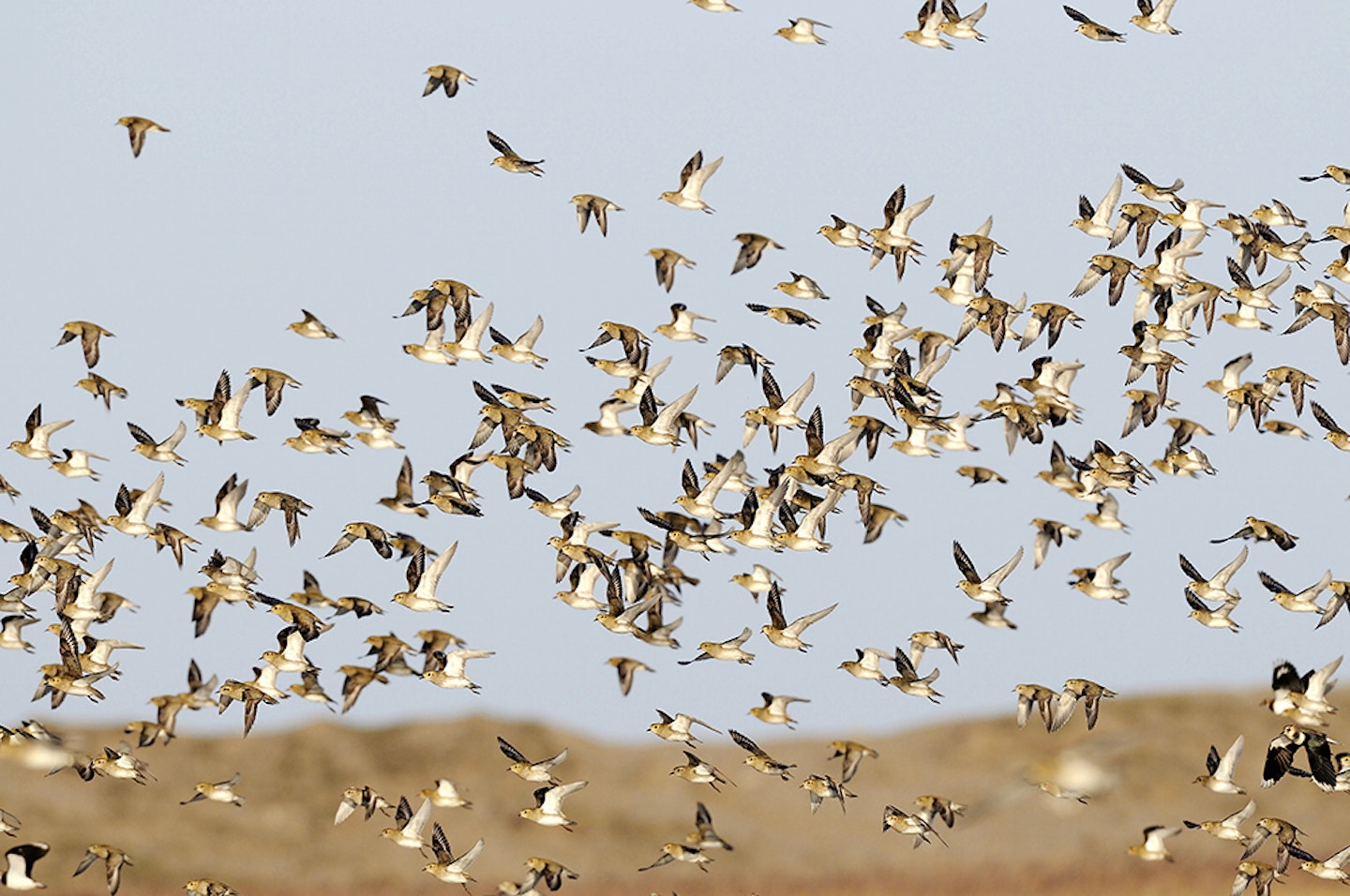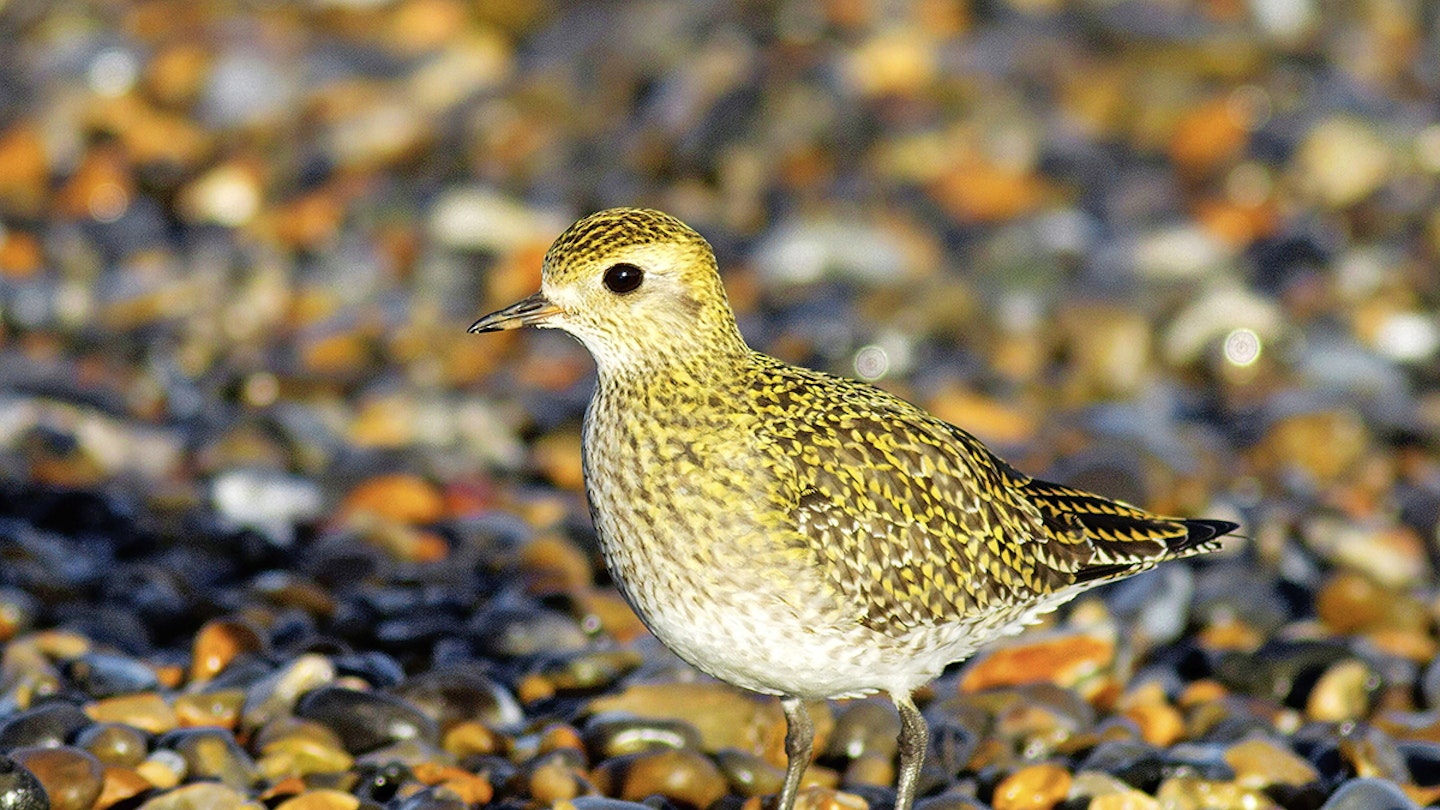-
Scientific name: Pluvialis apricaria
-
Length: 26-29cm
-
Wingspan: 67-76cm
-
UK numbers: 38,000-59,000 breeding pairs/ 420,000 wintering birds
Habitat: Upland moorlands/lowland fields
Diet: Insects, worms and beetles
What, might you guess, is the first thing a Golden Plover thinks about when it wakes up in the morning? Answers on a postcard, please. But you won’t get it. It is: “Where are the Lapwings?”
We’ve all seen mixed flocks of these two characters. These are a frequent, if localised, sight over much of lowland Britain in the winter months. There is even a collective term for the two species, the ‘Grassland Plovers,’ because they are so often seen together. They both eat the same food on winter fields, earthworms and a variety of insects and their larvae, so it is hardly surprising that they mix together.
But the relationship is more complicated than it appears. It so happens that what Lapwings do well is to find worm-rich patches of pasture in the first place, while Golden Plovers appear to be relatively clueless in this department. So Golden Plovers, on many occasions, literally hang about and wait for their colleagues to find the best feeding places, with the highest density of worms. Such patches differ season by season and day by day, perhaps hour by hour. Once the Lapwings settle and begin to feed, the Golden Plovers join them. The Lapwings are the pioneers, and the Golden Plovers are the hangers-on.
There are few more delightful, more dynamic sights than a mixed flock of these glorious birds. People get excited about Starling roosts, but for liveliness, colour and noise, there is little to beat winter Grassland Plovers, and the fact that they can be found on quite ‘ordinary’ farmland fields is a bonus (although unimproved grassland, a greatly diminished habitat, is their favourite). Both birds shine, even in the misty loaming of deep winter. The Lapwing, of course, is a marvel of iridescence, its apparently dark back being set ablaze by shy shafts of sunlight into the brilliant shimmering multi-green and violet canvas that it is. Golden Plovers, for their part, are covered in peppery spots, as gold as the packaging of chocolate coins.
On the fields, they feed in the same way, running a short distance, stopping to look, and running again until interrupted by the sight and snatch of an earthworm. When they all do it together, it is a dizzy sequence of unending stop-start staccato, as mesmerising in its way as a Starling extravaganza.
The extra bonus is the sound. Once they are settled, roosting Starlings shout and whistle like fans at a football match – and probably with the same insults thrown in! But both Lapwings and Golden Plovers make high-pitched calls with a mysterious, other-worldly quality. The Golden Plover is soft and so mournful that it seems to crack with emotion; meanwhile, the Lapwing, with its wailing yelps, is already crying.
Add the two together, shut your eyes and you could be listening to the audience of a heart-rending movie.
Dark arts
Although the sights and sounds are delightful to us, the relationship between the two species is tense. Once the Golden Plovers settle in among the Lapwings, the move immediately sets off bickering, food-stealing and other dark arts, before the birds finally settle into their social distancing rules of at least one metre apart. Lapwings attack Golden Plovers five times more often than the other way
round. Both are sight feeders, and if a close neighbour retreats into their space, they can be disturbed. You might be surprised how small the most popular worms are for Golden Plovers. Their optimal length is only 16-32mm. The birds eat little and often and, in terms of energy expended, it turns out that worms of this size are the most profitable. If a bird pulls out a larger worm, it takes longer to process.
Each of the plovers has different talents, and in the case of Golden Plover, while it isn’t so good as the Lapwing at finding good feeding sites, it is nimbler at profiting from them. And that’s important, because of a third species that often joins in the plover flocks uninvited – the Black-headed Gull. Gulls also eats worms and other invertebrates, as the plovers do, but when they attempt to come among the melee, their intentions are generally dishonourable. Rather than find food for themselves, they monitor what the plovers are doing and try to steal what they can.
And wouldn’t you know it? The gulls are much better at stealing food from Lapwings than they are from Golden Plovers. In one study, about 72% of gull attacks against Lapwings were successful, while only 38% of attempts to steal from Golden Plovers were successful. It seems that Golden Plovers are faster and more manoeuvrable, both on the ground and in the air. Lapwings also take longer to process food. They are more susceptible to tackling larger earthworms, which make the gulls’ eyes light up.
There is one small benefit of having gulls attending a flock – their vigilance. In studies, the Black-headed Gulls were often the first to detect human and other disturbance and monitor it; if they went up, so did the Lapwings, and then the plovers.
A swirling flock of Grassland Plovers is a wondrous sight. In the air, the two species diverge into separate universes. The Lapwings, with their rounded wings and contrasting black-and-white plumage, form straggly groups which, from a distance, may make them look like fragments of hot ash blowing away from a bonfire.

Distant shapes
The Golden Plovers, meanwhile, with their compact bodies and sharp-tipped wings, pack together in tight flocks and draw chevrons and discs in the sky. These shapes are so distinctive that, arguably, you could identify Golden Plovers from a greater distance than any other bird in Britain. Once aloft, they also have a distinctive habit of circling the fields, seemingly forever, before finally settling down to land; by which time the Lapwings are already into their starters and have pulled their crackers.
The Lapwings could potentially relish a short time away from the Golden Plovers. Not only do the latter swamp their self-found worm-rich fields, but there is some evidence that they bring the pestering gulls with them, too. Black-headed Gulls apparently sometimes join the Golden Plovers at their pre-feeding assemblies, and when the plovers look for the Lapwings, they follow them. The Lapwings lose out twice over; they must get sick of the sight of their star-spangled nuisance.
By a supreme irony, Golden Plovers get an unwelcome taste of their own medicine on their breeding grounds. The Dunlin often nests in the same areas as the plover (mainly the uplands of northern England and Scotland) and one of its old colloquial names is ‘Plover’s Page’. During the whole season, it routinely feeds in close company with the Golden Plover, sometimes as little as a metre away. The Dunlin feeds much more successfully, and spend far less time looking out for predators, when it associates with the Golden Plover, benefiting from the latter’s wariness.
Meanwhile, the arrangement does not seem to suit the plover, which often spends time trying to rid itself of its ‘Page.’ This odd association doesn’t just happen in the UK, but elsewhere, too, for example on the tundra of Fenno-Scandia and Iceland.
It might seem like natural justice, but of course, it is entirely irrelevant to the hard-pressed Lapwing that its nemesis is bothered in this way.
The plovers are only a pain to Lapwings in winter. The chances are that the moment it wakes up in the morning, a Lapwing says to itself, with a heavy heart: “Where are those @#$#$@# Golden Plovers?”
Where to see them
In summer, in the Southern Uplands and Highlands of Scotland, the Western and Northern Isles, the Peak District, North Yorkshire, Wales and Devon, they inhabit upland moorlands. In winter, they move to lowland fields.
